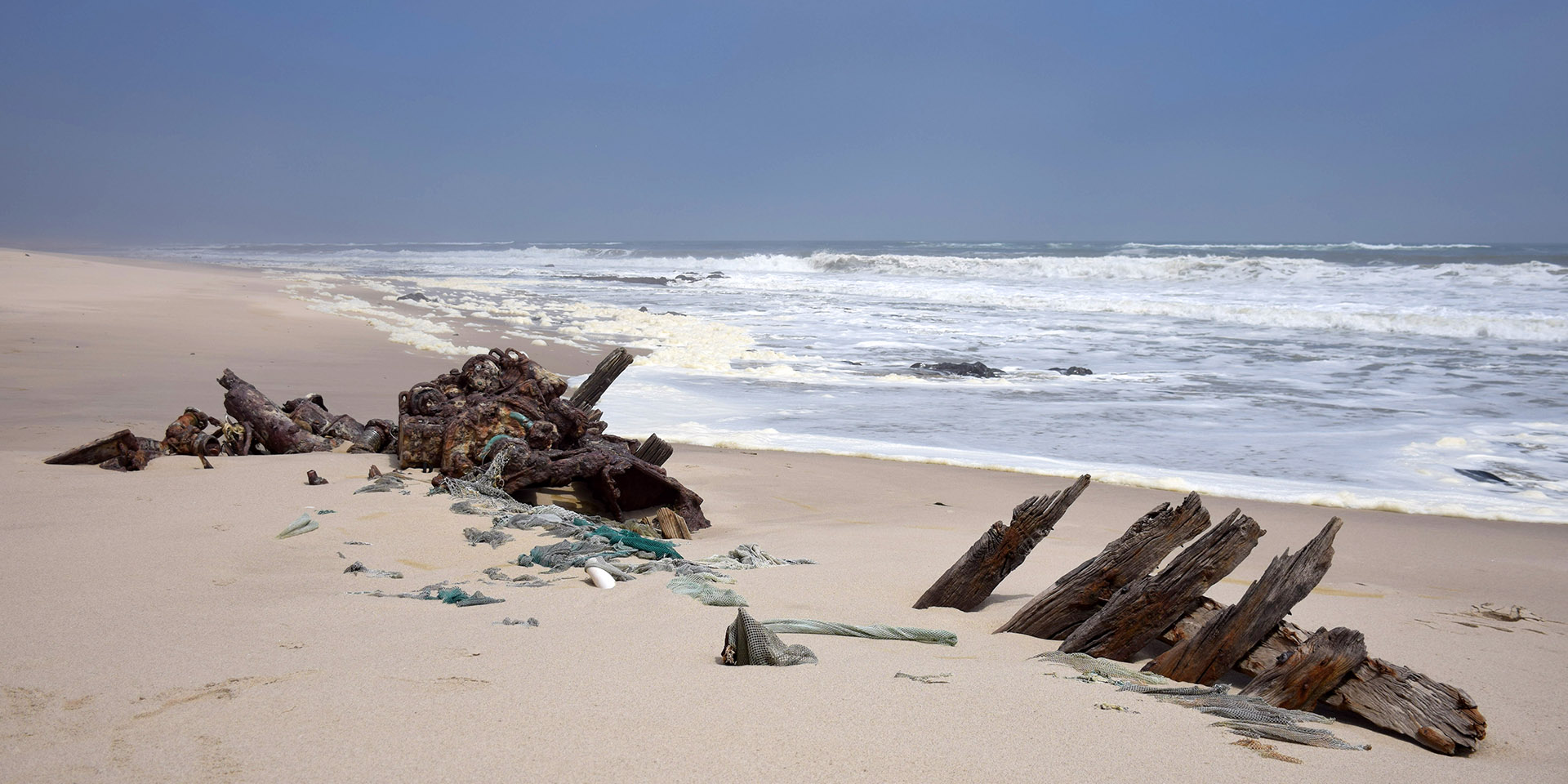The Skeleton Coast, a hauntingly beautiful stretch of Namibia’s northern coastline, is a place where nature’s stark elements collide. Known as one of the most inhospitable places on Earth, this region has captivated explorers, historians, and adventurers with its rugged beauty and eerie allure. The coastline stretches for over 500 kilometers, bordered by the icy waters of the Atlantic Ocean on one side and the towering dunes of the Namib Desert on the other.
What truly sets the Skeleton Coast apart are its forgotten shipwrecks and the mysteries shrouded in its perpetual fog. This unforgiving environment has claimed countless vessels over the centuries, leaving behind a maritime graveyard that tells tales of danger, survival, and despair. This article dives deep into the enigma of the Skeleton Coast, exploring its history, shipwrecks, and the secrets it still holds.
The Origin of the Name: A Graveyard of Ships and Bones
The Skeleton Coast derives its name from the whale bones and shipwrecks that litter its shores. To the indigenous San people, it was known as “The Land God Made in Anger,” while Portuguese sailors referred to it as “The Gates of Hell.” These ominous names reflect the perilous nature of this region, where harsh winds, unpredictable currents, and dense fog make navigation treacherous.
For centuries, the Skeleton Coast was a maritime hazard. Ships traveling along Africa’s western coast often fell victim to hidden sandbanks and strong swells, running aground in this desolate region. Survivors faced a bleak reality: miles of inhospitable desert, scarce freshwater, and little hope of rescue. The coastline’s haunting reputation endures, and its shipwrecks remain as ghostly monuments to its perilous past.
Forgotten Shipwrecks: Silent Witnesses of Tragedy
The Skeleton Coast is dotted with the remains of shipwrecks, some of which date back hundreds of years. These vessels, trapped in the sands and eroded by time, offer a glimpse into the region’s maritime history. Here are some of the most iconic wrecks that have come to define the Skeleton Coast:
- Eduard Bohlen (1909): Perhaps the most famous shipwreck on the Skeleton Coast, the German cargo ship Eduard Bohlen ran aground in 1909. Over a century later, it now lies stranded several hundred meters inland, surrounded by desert sands. The wreck serves as a chilling reminder of how the relentless desert encroaches on the sea.
- Dunedin Star (1942): The British cargo liner Dunedin Star was carrying supplies and passengers during World War II when it struck a sandbank and became stranded. The rescue operation was an epic struggle, involving planes, ships, and a grueling trek across the desert. The wreckage of the Dunedin Star is a stark testament to the challenges of survival on this unforgiving coast.
- Zeila (2008): One of the more recent shipwrecks, the Zeila fishing trawler became stranded near Henties Bay in 2008. Its rusting remains have become a popular tourist attraction, drawing visitors who are fascinated by the eerie beauty of this decaying vessel.
- Suiderkus (1976): This fishing vessel met its fate near Möwe Bay, a reminder of how even modern ships are not immune to the dangers of the Skeleton Coast. Its skeletal remains stand as a testament to the power of nature.
These shipwrecks, along with many others, are scattered along the coast, each with its own story of tragedy and survival. The harsh environment preserves them as haunting relics of the past.
The Perpetual Fog: Nature’s Deadly Trap
One of the defining features of the Skeleton Coast is its dense and persistent fog, a natural phenomenon caused by the meeting of the cold Benguela Current and the warm air of the Namib Desert. This thick fog blankets the coastline, reducing visibility to near zero and making navigation a nightmare for mariners.
The fog, while treacherous for ships, is a lifeline for the desert’s flora and fauna. Plants such as the iconic Welwitschia mirabilis and animals like fog-basking beetles rely on the moisture from the fog to survive. This unique ecosystem demonstrates nature’s resilience in one of the harshest environments on Earth.
The Wildlife of the Skeleton Coast: Thriving Against All Odds
Despite its harsh conditions, the Skeleton Coast is home to a surprising array of wildlife. The nutrient-rich Benguela Current supports a thriving marine ecosystem, attracting seals, fish, and seabirds. Large colonies of Cape fur seals are a common sight along the coast, particularly at places like Cape Cross, where tens of thousands of seals congregate.
Predators such as brown hyenas and desert-adapted lions roam the coastline, scavenging on seal carcasses or hunting small prey. Inland, animals like springboks, oryxes, and elephants navigate the arid landscape, finding water in hidden springs and ephemeral rivers.
The Skeleton Coast National Park, which encompasses much of this region, is a protected area aimed at preserving its unique biodiversity. Visitors to the park can witness the remarkable adaptations of its wildlife and gain a deeper appreciation for the resilience of life in extreme conditions.
Mysteries and Myths: The Allure of the Unknown
The Skeleton Coast is not just a graveyard for ships; it is also a place of mystery and legend. Stories of hidden treasure, ghost ships, and unexplored caves have captured the imagination of adventurers and historians alike. Some believe that ancient shipwrecks still lie buried beneath the sands, waiting to be discovered.
The remoteness of the region has also led to speculation about lost expeditions and undiscovered artifacts. While many of these tales remain unproven, they add to the mystique of the Skeleton Coast, drawing explorers who are eager to uncover its secrets.
Tourism on the Skeleton Coast: A Journey into the Unknown
Today, the Skeleton Coast is a growing tourist destination, attracting those who seek adventure and solitude. Guided tours and safaris offer visitors the chance to explore its rugged landscapes, from the towering dunes of the Namib Desert to the windswept beaches littered with shipwrecks.
One of the most unique ways to experience the Skeleton Coast is by air. Scenic flights provide breathtaking views of the coastline, revealing the stark contrasts between the desert and the ocean, as well as the haunting beauty of the shipwrecks.
Preserving the Skeleton Coast’s Legacy
Efforts to protect the Skeleton Coast’s unique environment and historical heritage are ongoing. Conservation initiatives aim to balance tourism with the preservation of its fragile ecosystems and cultural significance. By raising awareness of its history and natural wonders, Namibia is ensuring that the Skeleton Coast remains a place of intrigue and inspiration for future generations.
The Skeleton Coast is a place of stark contrasts and haunting beauty, where nature’s raw power is on full display. Its forgotten shipwrecks and foggy secrets tell stories of danger, resilience, and survival, while its unique ecosystem showcases the adaptability of life in extreme conditions. For those who venture into this remote and mysterious region, the Skeleton Coast offers a journey into the unknown, leaving an indelible mark on all who experience its wonders.
Join 'Namibia Today' WhatsApp Channel
Get the breaking news in Namibia — direct to your WhatsApp.
CLICK HERE TO JOIN












